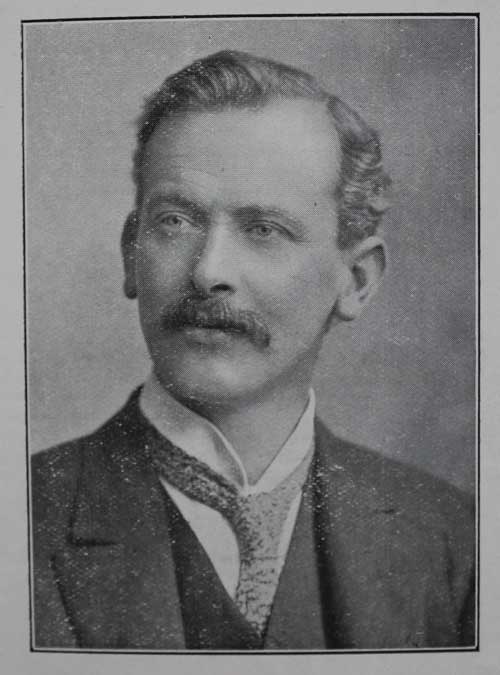Chance and Stevenson
Walter C Stevenson and Arthur Chance
Walter Clegg Stevenson (1877-1931) pioneered the use of radium treatment at Dr Steevens’ Hospital. He joined the staff in 1904 as assistant surgeon and radiologist and in 1911 he became the Surgeon, a position he held until 1916, when he was succeeded by Arthur Chance. During the First World War he served in France and on his return was appointed as consulting radiologist at Dr Steevens’. He and John Joly (1857-1933) were responsible for developing the ‘Dublin Method’ in radiology, a method which, as Leaney and Lunney (2009) note, ‘won acclaim from radium centres in New York, Brussels, Stockholm and London.’

Photograph of Walter C. Stevenson.
Stevenson’s paper in The Medical Press in March 1914 explained the new ‘Dublin Method’ as follows:
It is evident that it is essential to bury the radium to obtain the greatest efficiency in its use, as otherwise more than half the Gamma rays are lost. This can be done by the use of exploring needles containing the radium or its emanation in fine capillary tubes… The needles can be placed parallel and as close to, or as far apart from one another as is desirable, in accordance with the concentration of the radio-active material employed.
In effect the Dublin Method developed the precursor to the modern radium needle.
Stevenson provides us with an interesting insight into his work on radium at Dr Steevens’ Hospital in an article dated to 1925. In the following case of a gun shot wound to the thigh, sustained in 1914, he noted the successful treatment of the patient (one of the army pensioners treated at Dr Steevens’ Hospital), by his radium method:
G.S.W., Thigh. Crippled with sciatic pain since wounded, in 1914. Has had prolonged courses of treatment, including seven operations, two of which were on the sciatic nerve. Has had eight months diathermy treatment recently at Blackrock Pensions’ Hospital, which only produced temporary relief. Suffers from marked twitching and tremor of leg, which became very pronounced when the sole of the foot was touched. Walked stiffly with the aid of sticks. Flexion of the knew limited. Stretching exercises and massages impossible. After radiation, which was applied for six days on scarred area of thigh, 59.6 med. Gamma rays, patient could bear deep massage down the whole course of the sciatic nerve to the sole of the foot. Was able to flex and extend the knee well, though these movements continued to cause cramp in the calf muscles for a month after treatment, when the cramps disappeared. The patient at present has no cramps or tremors, is able to walk much further, and has not to depend on a stick, and gets a good night’s rest, which he was unable to do before.
Stevenson explained that of the 188 patients treated in 1925 100 had suffered from malignant diseases while 88 had, as in the above case, been treated for non-malignant conditions. This was a trend he continued, stating in 1929 that of the 2,000 patients he had treated with radium since 1914 about half of them had been radiated for non-malignant conditions. As time went on he was, however, becoming more aware of the undesirable effects of the treatment. As Coakley (1992) notes, the new method was not without danger and in 1929 Stevenson himself drew attention to this fact in his paper on ‘The uses of radium in medicine’, declaring that ‘No account of radium is complete without a very grave note of warning to those who employ it of the risks they run of burning their fingers, starting an epithelioma in their hands or producing a fatal anaemia.’

Plaque to Arthur Chance.
His successor, Arthur Joseph Chance (1889-1980) reigned as orthopaedic surgeon at Dr Steevens’ Hospital for the first half of the twentieth century. He had been appointed Surgeon to Dr Steevens’ Hospital in 1916 and remained in the post for the next fifty years, becoming chairman to the Board of Governors in 1954 until 1972. As Professor of Surgery at the Royal College of Surgeons of Ireland he, like other doctors at Dr Steevens’, worked in other Dublin hospitals, and, as the first Chairman of the Central Council of the Federated Dublin Hospitals (1961-4) played an important role in the development of the Federated Hospitals of Dublin.
Sources
Andrews, Helen (2009), ‘Chance, Arthur Joseph’, in Dictionary of Irish Biography (Cambridge University Press).
Coakley, Davis (1992), Irish Masters of Medicine (Dublin: Town House).
Leaney, Enda and Lunney, Linde (2009), ‘Stevenson, Walter Clegg’, Dictionary of Irish Biography (Cambridge University Press).
Stevenson, W. C. (1914), ‘An economical method of using radium for therapeutic purposes’ in The Medical Press, 97, NS, pp. 251-2.
Stevenson, W. C. (1925), ‘Report on one Years’s Radium Work Carried Out in 1925’, reprinted from the Report of the Irish Radium Committee for the Year 1925, SCIENTIFIC PROCEEDINGS OF THE ROYAL DUBLIN SOCIETY, September, 1926, Volume xviii, No. 26.’
Stevenson, W. C. (1929), ‘The Use of Radium in Medicine’, reprint from The Irish Journal of Medical Science November 1929’.

